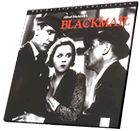

UK suspense
1929
bw 78 min.
Director: Alfred Hitchcock
CLV: $29.95 - available
1 disc, catalog # CC1297L
Blackmail was Alfred Hitchcock's tenth picture in England, his
second thriller and first British talkie -- and it marked an important
crossroads in film history. Hitchcock shot the film in 1929 as a
silent picture, but when it was ready for silent editing, John
Maxwell, the producer of the movie, set up a temporary sound stage
with RCA equipment imported from America. It was then very costly and
technically difficult to add post-dubbing, and Hitchcock had to
reshoot part of the film with live music and off-stage sound
effects. But the leading actress in the film, Anny Ondra, was Czech
and German and had an accent you could cut with a knife. So Hitchcock
hired a young actress named Joan Barry to speak Anny Ondra's Cockney
lines off-camera, while Ondra mouthed them in front of the camera.
Blackmail was based on a hit play by Charles Bennett, who
went on to write some of Hitchcock's greatest films: The Man Who
Knew Too Much (1934), The 39 Steps (1935), Secret
Agent (1936), Sabotage (1936), Young and Innocent
(1938), and Foreign Correspondent (1940), for which he received
an Academy Award nomination for Best Screenplay.
Blackmail had all the ingredients of the perfect thriller,
and Hitchcock had some clever tricks with sound, like the repetition
of the word knife which rises to a scream as Anny Ondra relives the
moment of her crime. The film has the visual appeal of a silent film
and an incredible suspense that builds and culminates during the chase
at the British Museum. The spectacular climax anticipated the Statue
of Liberty scene in Saboteur (1942), the Mount Rushmore scene in North
by Northwest (1959), and other classic Hitchcock sequences.
Hitchcock shot the British Museum scene using transparencies and
the Shuftan process (which combines painted and live-action imagery in
the camera, using a windowed mirror). Maxwell thought that the
shooting of special visual effects would delay the production and put
the film over budget, so Hitchcock did the effects without Maxwell's
knowledge. As a cover, Hitchcock set up a camera on the sidelines,
photographing a letter for an insert in case someone from the
production office showed up uninvited. When Maxwell saw the film, he
was totally surprised.
Blackmail marked Hitchcock's first cameo appearance -- on a
train, sitting behind his two leading actors. Hitchcock had appeared
in his first thriller, The Lodger, in 1926. "It all started with a
shortage of extras in my first thriller," Hitchcock once said. "It was
in for a few seconds as an editor with my back to the camera. It
wasn't really much, but I played it to the hilt. Since then, I have
been trying to get into every one of my pictures. It isn't that I like
the business, but it has an impelling fascination that I can't
resist. When I do it, the cast, the grips, the cameramen and everyone
else gather to make it as difficult as possible for me. But I can't
stop now."
Blackmail was an event when it was released in November
1929, advertised as "The First British Talkie!" Critics loved the
film, and Michael Powell, the famous British
screenwriter-director-producer of Peeping Tom (1960), who had
been the still photographer on Blackmail, wrote in his
autobiography that it put Hitchcock "on top of the heap ... When the
film reached Hollywood, Hitch was deluged with offers. But he wasn't
ready to go. Yet." Hitchcock moved to America in 1939, ten years
later.
Hitchcock proved with Blackmail that he understood perfectly
the visual flow of the film medium, as well as the possibilities that
sound could offer. Blackmail was, according to one critic of
that time, "the most intelligent compromise between talk and pictures
that has yet been found, and, as one would expect from Mr. Hitchcock,
it is a blaze of pictorial cleverness and technical skills." And as
such, a preview of the dark brilliant films to follow.
-- LAURENT BOUZEREAU
Credits
Directed and adapted by: Alfred Hitchcock
From the play by: Charles Bennett
Dialogue by: Benn Levy
Photography: Jack Cox
Art Director: W.C. Arnold
Music compiled and arranged by: Hubert Bath, Harry Stafford
Transfer
This edition of Blackmail was mastered from the finest elements
available. It does contain some audio and video deficiencies. We
believe, however, that this version of Blackmail is the best
available.




